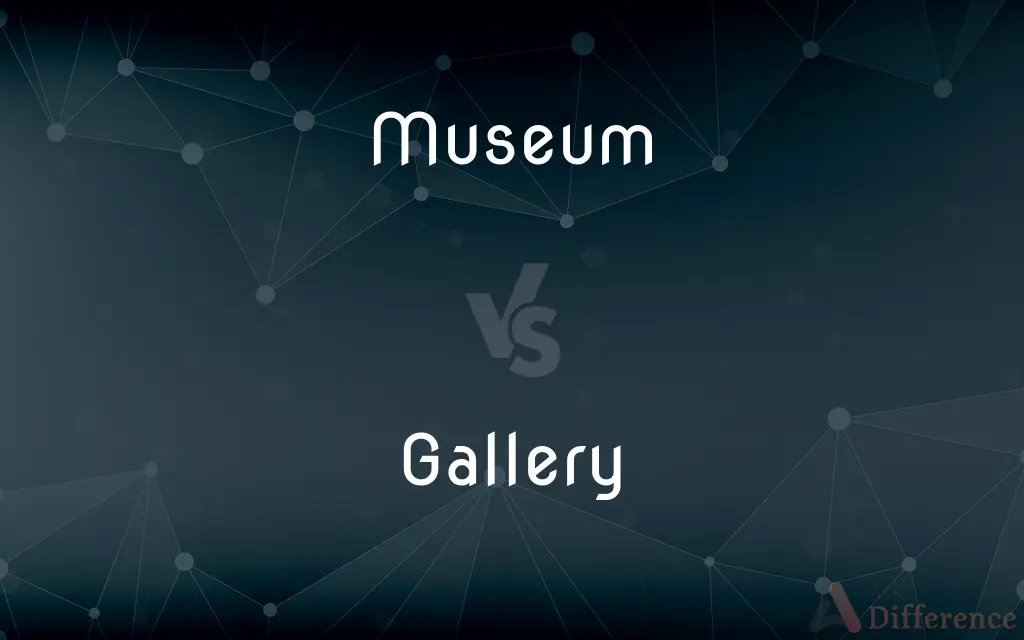Museum vs. Gallery — What's the Difference?
By Tayyaba Rehman & Urooj Arif — Updated on March 21, 2024
A museum showcases a diverse collection of artifacts and historical items, while a gallery primarily focuses on displaying art.

Difference Between Museum and Gallery
Table of Contents
ADVERTISEMENT
Key Differences
Museums and galleries both serve as cultural institutions dedicated to preserving and exhibiting objects, but their focuses and purposes vary significantly. Museums are known for their wide-ranging collections that include historical artifacts, scientific specimens, and cultural objects. They aim to educate the public, preserve history, and conduct research. Whereas galleries, particularly art galleries, focus on displaying artworks such as paintings, sculptures, and photographs. Their main goal is to promote and sell art, providing a platform for artists to showcase their work.
Museums often have permanent collections that they own, displaying items that have significant historical, scientific, or cultural importance. These collections are carefully curated and can include a variety of objects from ancient artifacts to modern scientific tools. On the other hand, galleries usually exhibit works that are on loan or for sale. They often host temporary exhibitions focusing on contemporary artists or specific art movements, aiming to introduce new artists and sell artwork to collectors and the general public.
Another key difference lies in their educational objectives. Museums typically offer a wide range of educational programs and materials, including workshops, lectures, and interactive exhibits, aimed at a broad audience. They strive to make learning accessible and engaging. Galleries, while they may also hold talks and openings, tend to have a more commercial focus. Their events are often aimed at networking and promoting sales rather than providing educational content.
The experience of visiting a museum is usually aimed at learning and exploration. Museums are often larger and may require more time to explore fully. They provide context for their exhibits through detailed descriptions, multimedia presentations, and guided tours. Galleries, in contrast, offer a more intimate setting focused on appreciation and contemplation of art. The atmosphere is typically quieter, with emphasis placed on the visual experience of the art itself.
Funding and management also differ between museums and galleries. Museums are usually funded by governments, private donations, and ticket sales, and are managed by professional staff and curators. They are non-profit entities aimed at serving the public interest. Galleries are often privately owned or operated by artists' collectives. They function as businesses, with the primary goal of selling art and supporting artists financially.
ADVERTISEMENT
Comparison Chart
Focus
Broad (history, science, culture)
Art (paintings, sculptures)
Purpose
Education, preservation, research
Promotion, sales of art
Collections
Permanent, owned by the museum
Temporary, often for sale
Educational Programs
Extensive (workshops, lectures)
Limited (artist talks, openings)
Experience
Learning and exploration
Appreciation of art
Management
Non-profit, publicly or privately funded
Commercial, privately owned
Size
Often large, multiple exhibits
Typically smaller, focused exhibits
Compare with Definitions
Museum
A building or institution dedicated to the acquisition, conservation, study, exhibition, and educational interpretation of objects having scientific, historical, or cultural value.
The Smithsonian in Washington, D.C., is one of the largest museums in the world.
Gallery
Galleries can also refer to online platforms for displaying art.
The photographer launched an online gallery to showcase his work globally.
Museum
Museums often include research facilities and offer educational programs.
The museum offers summer camps for children interested in space and science.
Gallery
A room or building for the display or sale of works of art.
The downtown gallery is hosting a contemporary art exhibition this month.
Museum
A place where items of historical, artistic, or cultural interest are exhibited, preserved, and studied.
The local history museum showcases artifacts from the town’s founding era.
Gallery
Primarily commercial enterprises focused on the art market.
The gallery owner travels to art fairs worldwide to find new pieces for the collection.
Museum
An institution for collecting and displaying objects of historical, scientific, and cultural interest.
The natural history museum features dinosaur skeletons and a butterfly conservatory.
Gallery
Often focuses on contemporary art and emerging artists.
The gallery specializes in street art and graffiti from local artists.
Museum
They are typically non-profit and serve the public interest.
The museum’s new exhibit on ancient Egypt was funded by donations and grants.
Gallery
An establishment that displays and sells artworks to the public.
The artist will have her paintings featured in the main street gallery.
Museum
A museum ( mew-ZEE-əm; plural museums or, rarely, musea) is an institution that cares for (conserves) a collection of artifacts and other objects of artistic, cultural, historical, or scientific importance. Many public museums make these items available for public viewing through exhibits that may be permanent or temporary.
Gallery
A room or building for the display or sale of works of art
The National Gallery
An art gallery
Museum
A building in which objects of historical, scientific, artistic, or cultural interest are stored and exhibited
The Museum of Modern Art
A museum curator
The museum is noted for its fine fossil collection
It is difficult to avoid the feeling that the city is now a living museum
Gallery
A balcony or upper floor projecting from an interior back or side wall of a hall or church, providing space for an audience or musicians
In the minstrels' gallery, a string orchestra plays themes from film soundtracks
Museum
A building, place, or institution devoted to the acquisition, conservation, study, exhibition, and educational interpretation of objects having scientific, historical, or artistic value.
Gallery
A long room or passage, typically one that is partly open at the side to form a portico or colonnade.
Museum
A building or institution dedicated to the acquisition, conservation, study, exhibition, and educational interpretation of objects having scientific, historical, cultural or artistic value.
Visit the history museum
They're opening a new coin exhibition at the local museum.
Gallery
A roofed promenade, especially one extending along the wall of a building and supported by arches or columns on the outer side.
Museum
A repository or a collection of natural, scientific, or literary curiosities, or of works of art.
Gallery
A long enclosed passage, such as a hallway or corridor.
Museum
A depository for collecting and displaying objects having scientific or historical or artistic value
Gallery
A narrow balcony, usually having a railing or balustrade, along the outside of a building.
Gallery
A projecting or recessed passageway along an upper story on the interior or exterior of a large building, generally marked by a colonnade or arcade.
Gallery
Such a passageway situated over the aisle of a church and opening onto the nave. Also called tribune2.
Gallery
Southwestern Gulf States See veranda.
Gallery
An upper section, often with a sloping floor, projecting from the rear or side walls of a theater or an auditorium to provide additional seating.
Gallery
The seats in such a section, usually cheaper than those on the main floor.
Gallery
The cheapest seats in a theater, generally those of the uppermost gallery.
Gallery
The audience occupying a gallery or cheap section of a theater.
Gallery
A large audience or group of spectators, as at a tennis or golf match.
Gallery
The general public, usually considered as exemplifying a lack of discrimination or sophistication
Accused the administration of playing to the gallery on the defense issue.
Gallery
A building, room, or website for the exhibition of artistic work.
Gallery
An establishment that displays and sells works of art.
Gallery
A photographer's studio.
Gallery
A collection; an assortment
The trial featured a gallery of famous and flamboyant witnesses.
Gallery
An underground tunnel or passageway, as in a cave or one dug for military or mining purposes.
Gallery
A tunnel or series of tunnels made by an animal.
Gallery
(Nautical) A platform or balcony at the stern or quarters of some early sailing ships.
Gallery
A decorative upright trimming or molding along the edge of a table top, tray, or shelf.
Gallery
An institution, building, or room for the exhibition and conservation of works of art.
Gallery
An establishment that buys, sells, and displays works of art.
Gallery
The uppermost seating area projecting from the rear or side walls of a theater, concert hall, or auditorium.
Gallery
The spectators of an event, collectively.
Gallery
(legal) The, often elevated and in the rear, part of a courtroom where seating for the public audience is facilitated during trial.
Gallery
A roofed promenade, especially one extending along the wall of a building and supported by arches or columns on the outer side
Gallery
(computing) A browsable collection of images, font styles, etc.
A gallery of image thumbnails
A clip-art gallery in a wordprocessor
Gallery
(fortification) A covered passage cut through the earth or masonry.
Gallery
(mining) A level or drive in a mine.
Gallery
(automotive) A channel that carries engine oil to parts of the engine that need lubrication, such as the main bearings.
Gallery
(television) The production control room.
Gallery
A part of a monocle, a projection off the ring holding the lens, which helps secure the monocle in the eye socket.
Gallery
(entomology) The boring trails produced by an insector only beetles? in wood.
Beetle gallery
Gallery
(Trinidad and Tobago) To show off.
Gallery
A long and narrow corridor, or place for walking; a connecting passageway, as between one room and another; also, a long hole or passage excavated by a boring or burrowing animal.
Gallery
A room for the exhibition of works of art; as, a picture gallery; hence, also, a large or important collection of paintings, sculptures, etc.
Gallery
A long and narrow platform attached to one or more sides of public hall or the interior of a church, and supported by brackets or columns; - sometimes intended to be occupied by musicians or spectators, sometimes designed merely to increase the capacity of the hall.
Gallery
A frame, like a balcony, projecting from the stern or quarter of a ship, and hence called stern gallery or quarter gallery, - seldom found in vessels built since 1850.
Gallery
Any communication which is covered overhead as well as at the sides. When prepared for defense, it is a defensive gallery.
Gallery
A working drift or level.
Gallery
Spectators at a golf or tennis match
Gallery
A porch along the outside of a building (sometimes partly enclosed)
Gallery
A room or series of rooms where works of art are exhibited
Gallery
A long usually narrow room used for some specific purpose;
Shooting gallery
Gallery
A covered corridor (especially one extending along the wall of a building and supported with arches or columns)
Gallery
Narrow recessed balcony area along an upper floor on the interior of a building; usually marked by a colonnade
Gallery
A horizontal (or nearly horizontal) passageway in a mine;
They dug a drift parallel with the vein
Common Curiosities
Can galleries sell the artworks they display?
Yes, galleries primarily focus on the promotion and sales of art.
Can a museum also have art exhibitions?
Yes, many museums have art collections and host temporary art exhibitions.
Do museums charge for entry?
Some museums charge admission fees, while others are free and rely on donations.
How do museums acquire their collections?
Museums acquire items through donations, purchases, and sometimes through archaeological excavations.
How do galleries support artists?
Galleries promote artists' work, host exhibitions, and sell artworks, providing financial and professional support to artists.
What kind of educational programs do museums offer?
Museums offer a variety of educational programs, including workshops, lectures, and interactive exhibits.
What is the main purpose of a museum?
Museums aim to educate, preserve history, and conduct research.
Are all galleries privately owned?
Most galleries are privately owned, but some are operated by artists’ collectives or non-profit organizations.
What is the difference between an art museum and an art gallery?
An art museum is a non-profit institution focusing on displaying, preserving, and researching art, while an art gallery is a commercial enterprise aimed at promoting and selling art.
Can galleries have permanent collections?
While galleries primarily host temporary exhibitions, some may hold small permanent collections, especially if associated with a particular artist or style.
Can anyone open an art gallery?
Yes, with the necessary resources and expertise in the art market, anyone can open a gallery.
How do museums and galleries differ in size and layout?
Museums are often larger and may require more time to explore, while galleries offer a more intimate setting focused on specific artists or styles.
Do galleries offer educational content?
While galleries may host artist talks and openings, their educational content is usually more limited compared to museums.
Are there different types of museums?
Yes, there are many types, including art, history, science, and natural history museums, each focusing on different fields.
Do museums only display old objects?
No, museums can display objects from various time periods, including contemporary works and recent scientific discoveries.
Share Your Discovery

Previous Comparison
Expert vs. Expertise
Next Comparison
Possibility vs. OpportunityAuthor Spotlight
Written by
Tayyaba RehmanTayyaba Rehman is a distinguished writer, currently serving as a primary contributor to askdifference.com. As a researcher in semantics and etymology, Tayyaba's passion for the complexity of languages and their distinctions has found a perfect home on the platform. Tayyaba delves into the intricacies of language, distinguishing between commonly confused words and phrases, thereby providing clarity for readers worldwide.
Co-written by
Urooj ArifUrooj is a skilled content writer at Ask Difference, known for her exceptional ability to simplify complex topics into engaging and informative content. With a passion for research and a flair for clear, concise writing, she consistently delivers articles that resonate with our diverse audience.
















































